

Self Inflating Balloon: Baking Soda and Vinegar Balloon Experiment
This post may contain affiliate links.
Have you ever tried the baking soda and vinegar balloon experiment? This classic science experiment is really one of my favorites. It is an easy science experiment to do and it really is exciting to watch. It creates a self-inflating balloon that kids think is the coolest!
The reaction between the baking soda and vinegar cause the balloon to inflate all on its own! It is a show-stopper experiment for kids.
(See more of my STEM projects for kids.)

How to Do the Baking Soda and Vinegar Balloon Experiment:
Supplies you will need for this simple science experiment:.

Plastic empty water bottle or soda bottles, cleaned out Large Balloon White Vinegar (acetic acid) Baking Soda (or sodium bicarbonate) Small Funnel Spoon
TIP: Before starting the experiment, you will want to stretch out the balloon to make it more loose and easier to inflate.
Step 1- Pour 1-2 spoonfuls of baking soda into the opening of the balloon, using a funnel. You’ll need to shake it a bit to get it down into the base of the balloon.
Step 2- Use the funnel again and pour some vinegar into the empty plastic bottle until it is about an inch or two deep- maybe a few tablespoons of vinegar. Exact amounts do not matter. Add a few drops of food coloring to change it up if you want- totally unnecessary.

Step 3- Carefully stretch the opening of the balloon around the mouth of the bottle leaving it hanging down until you are ready for the reaction.
TIP: Don’t let any of the baking soda dump into the bottom of the bottle while attaching it.
Step 4- When you are ready to see the chemical reaction happen, lift up the balloon allowing the baking soda to fall down into the bottle.

This is when the fun starts! Baking soda and vinegar mix to create an awesome chemical reaction. The gas from combining the two will escape as bubbles of carbon dioxide gas that cause the balloon to inflate. It’s impressive. The more gas there is created, the larger the balloon will get.
Your kids, if they are anything like mine, will beg to do the experiment again, then 10 more times! This is really a perfect science project for kids to try on their own.

If you do repeat it, you will need fresh vinegar in the bottle. Once a reaction happens, it is not quite so strong the second time through. The balloon does not usually inflate again unless the vinegar is fresh.My kids were amazed and wanted to do it again and again and again. Stock up on baking soda and vinegar if you are planning this one! Luckily they are both quite inexpensive.
(It’s a good thing they are both so cheap!)
The Science Behind It: Why the Baking Soda and Vinegar Reaction Works?
When the baking soda and vinegar reaction happens, it is an acid-base reaction. Vinegar is the acid and baking soda is the base. This reaction between the two causes a gas called carbon dioxide to bubble and foam. This gas having nowhere else to go, expands the balloon making the self-inflating balloon happen.
Here is the chemical equation behind it: Baking soda + vinegar — yields carbon dioxide + water + sodium ion + acetate ion There is more to it than that, but that’s the basic explanation.
Try some variations to see if other reactions work:
Will baking powder work instead of baking soda?
Would lemon juice work instead of vinegar?
Could you do the same thing with an alka-seltzer tablet and soft drinks?
Use the scientific method to investigate different variations on this experiment to see how they work.
Want More Baking Soda and Vinegar Experiments?
We love the carbon dioxide reactions that these two substances create.
Check out these other ones we have done:
Easy Bottle Rocket Experiment
Bathtub Bottle Rocket
Film Canister Rocket Experiment
How to Make a Volcano experiment! (This one is fun because when the eruption occurs, the carbon dioxide bubbles pour over like lava!
Former school teacher turned homeschool mom of 4 kids. Loves creating awesome hands-on creative learning ideas to make learning engaging and memorable for all kids!
Similar Posts

Computer Coding For Kids- Books and Apps

Roll a Beetle Dice Math Game
Zometools- stem construction toys.

Kitchen Chemistry: Cake Experiment

Thermometer Math: Temperature Conversions

Simple Science: How to Make Floating Zucchini Boats
What a great idea! I can’t believe I haven’t heard of this experiment. My girls are 12 and 11 and still love doing at home science projects. Although they use Time4Learning science curriculum it is always fun to do your own.
Thanks for the idea!
Awesome! I’m making a list of simple, fun experiments to do this summer, and I’m adding this one to it! We don’t seem to get to these types of experiments during the regular school year! Stopping by from HHH and new follower! Thanks for sharing your experiment!
My boys loved this experiment too. 🙂
- Pingback: Fizzing & Bubbling Science Experiments - Teach Beside Me
I do experiments with 4 year old grandson, he loves this one. We did the volcano as well and now he explains what happens to everyone he wants to show it too. Thank you for sharing, it is fun teaching when the things work as well as yours.
fantastic from a grammy
Nice , it is possible to send easy experiments for kids with the help of video
Leave a Reply Cancel reply
You must be logged in to post a comment.
Cool Science Experiments Headquarters
Making Science Fun, Easy to Teach and Exciting to Learn!
Science Experiments
Balloon Blow-up Science Experiment
Can you blow up a balloon without using your mouth? In this simple science experiment, we’re going to show you how to do it with only a few everyday items you probably already have in your home. It makes a great experiment for young children because the set-up is simple and it only takes a few minutes to get to the exciting finale.
In addition to a video demonstration and detailed printable instructions, we also have the scientific explanation of how this simple chemical reaction works making it perfect for older scientists too.
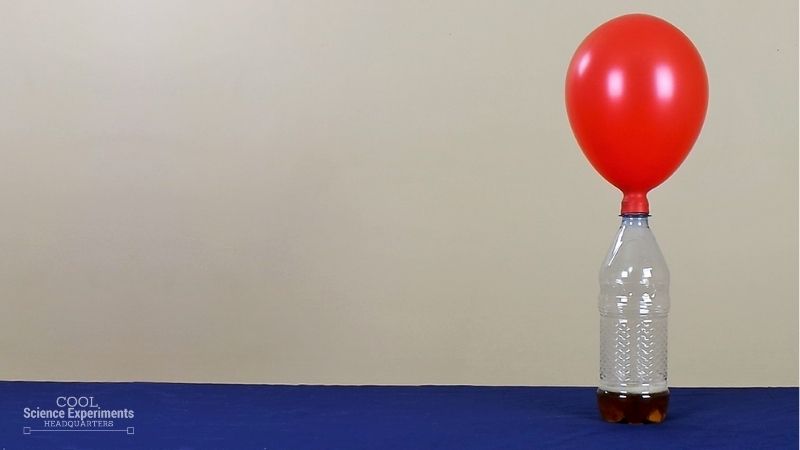
JUMP TO SECTION: Instructions | Video Tutorial | How it Works
Supplies Needed
- Small Soda Bottle
- Baking Soda
Balloon Blow-up Science Lab Kit – Only $5
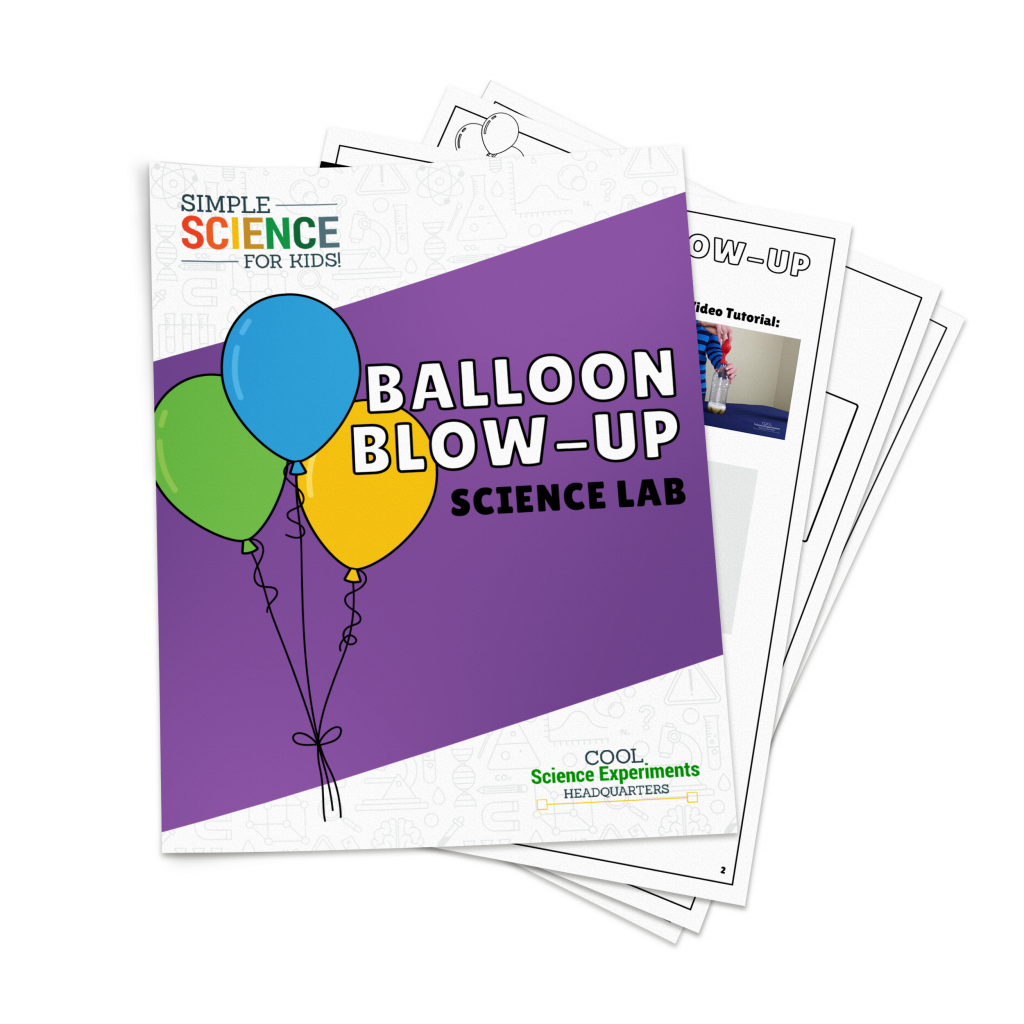
Use our easy Balloon Blow-up Science Lab Kit to grab your students’ attention without the stress of planning!
It’s everything you need to make science easy for teachers and fun for students — using inexpensive materials you probably already have in your storage closet!
Balloon Blow Up Science Experiment Instructions
Step 1 – Start with some questions: How do you blow up a balloon? What if I told you that you couldn’t blow air into it, do you think you could still inflate (blow-up) the balloon? Then observe the supplies for the experiments. Do you think they can be use to blow up the balloon? If so how? Write down your hypothesis (prediction).

Step 2 – Using a funnel, pour about a third of a cup of vinegar into the bottle. We used Apple Cider Vinegar, but any type of vinegar will work.
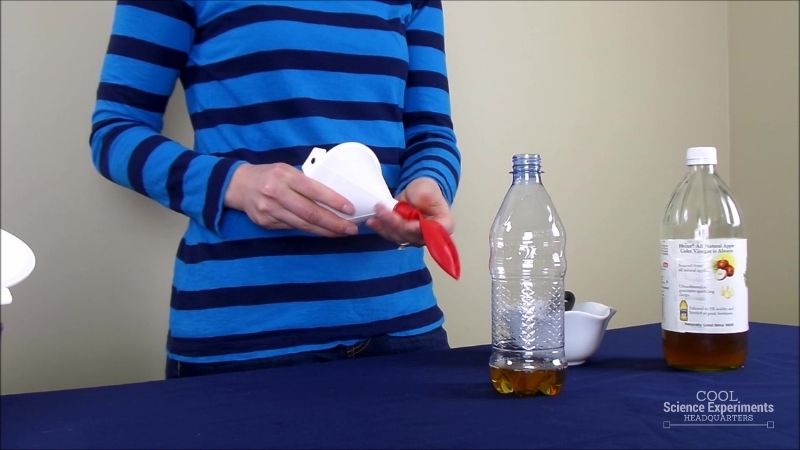
Step 3 – Then insert another funnel into the mouth of the balloon. We recommend using two different funnels. One funnel for filling the bottle with vinegar and one for the balloon. However, you can do the experiment with only one funnel. Just make sure you completely wash and dry the funnel after you add the vinegar and before you put it into the balloon. This is very important.
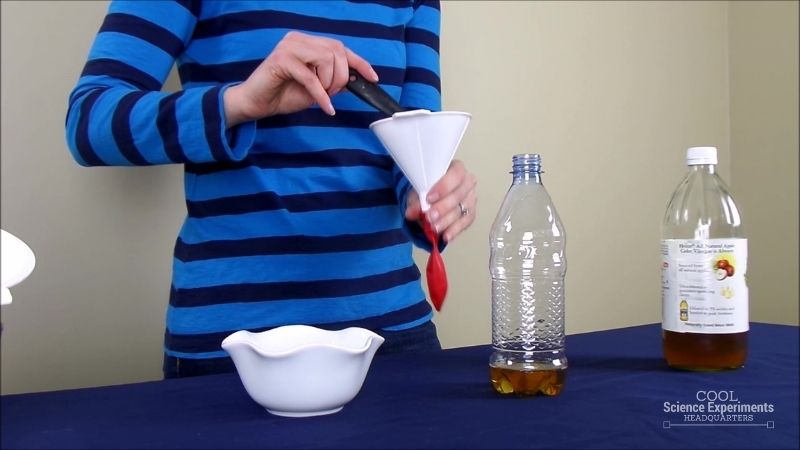
Step 4 – Place two teaspoons of baking soda into the funnel so it falls into the balloon. When the balloon is filled with the baking soda, carefully remove it from the funnel.
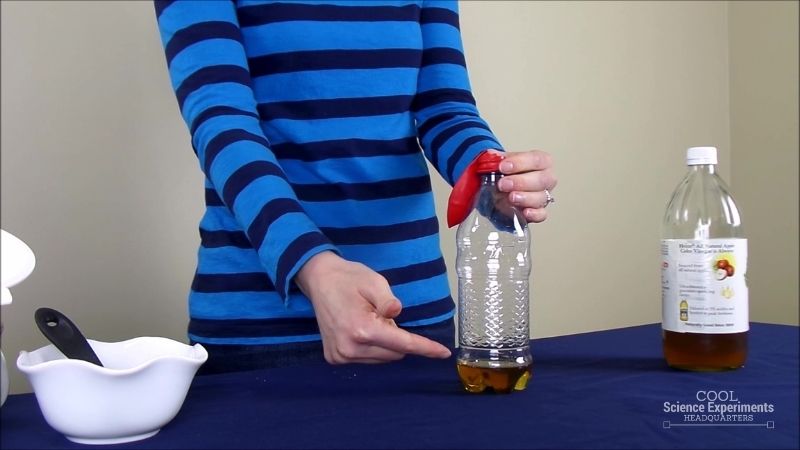
Step 5 – Next, secure the mouth of the balloon over the mouth of the bottle. Take your time doing this and don’t let any of the baking soda fall out of the balloon and into the bottom of the bottle. Take a moment to make some observations. What will happen if we lift up the balloon? Write down your hypothesis (prediction) and then test to see if you were right!
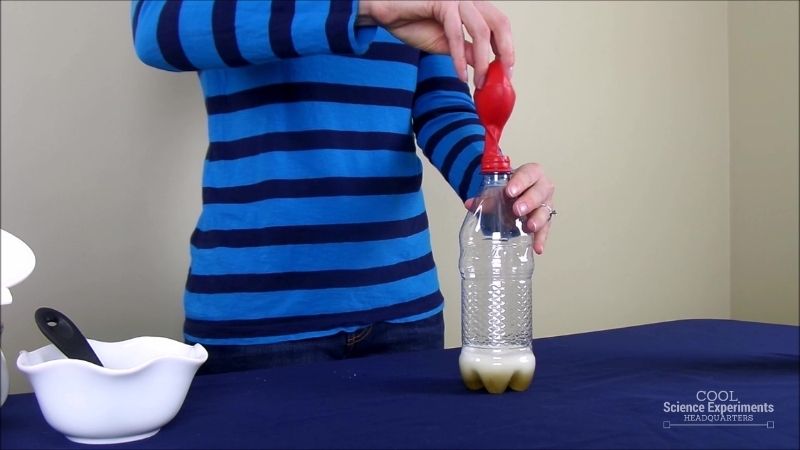
Step 6 – While holding the bottle, lift the end of the balloon and allow the baking soda to drop into the bottle.
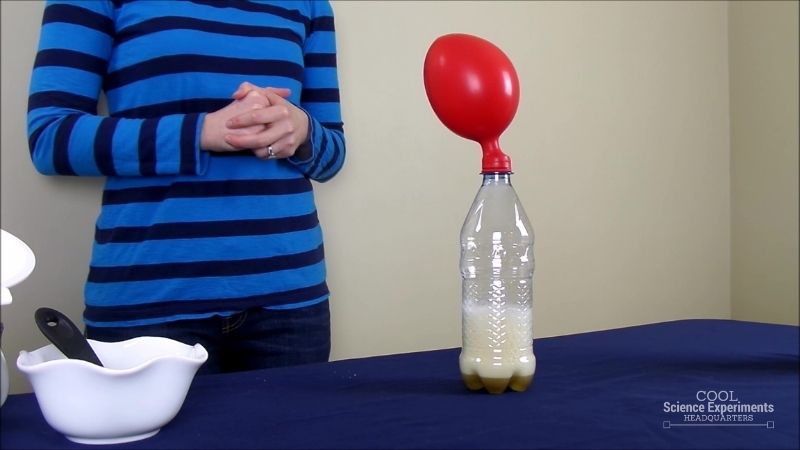
Step 7 – What happens to the balloon? Was your hypothesis correct? Wondering what caused the balloon to inflate? Find out the answer in the how does this experiment work section below.
Video Tutorial
How Does the Science Experiment Work?
When baking soda (a base) and vinegar (an acid) are mixed together they create a chemical reaction that results in the formation of carbon dioxide gas. Gases do not have a specific shape or volume, rather they expand rapidly filling their container. Gases expand rapidly because their particles move at high speeds in all directions. As the carbon dioxide gas fills the bottle, it has nowhere else to go so it begins to fill the balloon. As the carbon dioxide gas fills the balloon, the balloon inflates. The more gas that is created, the larger the balloon will inflate.
The baking soda and vinegar chemical reaction will continue to inflate the balloon as long as there is still baking soda and vinegar to react. Once the reaction between baking soda and vinegar has stopped, the balloon will slowly begin to deflate.
An acid is a substance that tastes bitter, reacts with metals and carbonates, and turns blue litmus paper red. A base is a substance that tastes bitter, feels slippery, and turns red litmus paper blue.
Other Ideas to Try
Does changing the amount of baking soda and vinegar change the size of the balloon when it inflates? What would happen if you used another acid like lemon juice instead of the vinegar? Would it react the same with the baking soda?
I hope you enjoyed the experiment. Here are some printable instructions:
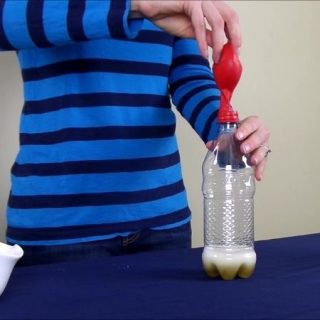
Instructions
- Using a funnel, pour about a third of a cup of vinegar into the bottle. Tip: I used Apple Cider Vinegar, but any kind of vinegar will work.
- Then insert another funnel into the mouth of the balloon. Tip: It is best to have two funnels, one for filling the bottle with vinegar and one for the balloon. If you only have one funnel, it is important that you completely wash and dry the funnel after you add the vinegar and before you put it into the balloon.
- Place two teaspoons of baking soda into the funnel so it falls into the balloon. Then remove the balloon from the funnel.
- Next, secure the the mouth of the balloon over the top of the bottle. Tip: Don’t let any of the baking soda drop into the bottle…yet!
- While holding the bottle, lift the end of the balloon allowing the baking soda to drop into the bottle.
- Watch in amazement as the balloon magically inflates!
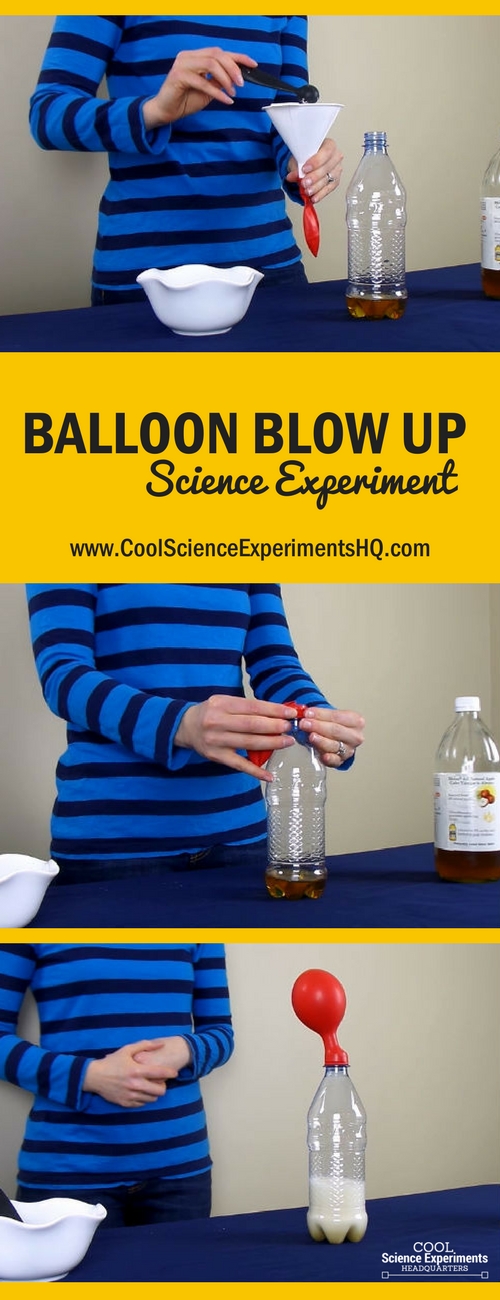
Reader Interactions
November 2, 2017 at 11:00 am
Yeah but don’t just eyeball the measurements of things because if you use to much baking soda it will make the baloon spring a leak and all sorts of stuff will fly out and make a big mess.
I speak form experience
Seriously, don’t do this
April 21, 2018 at 10:26 am
I did this experiment and it is perfect!
You need to hold properly the bottle when you mix the baking soda into vinegar.
May 22, 2019 at 8:57 am
We’re doing science experiments at school and this one is brilliant! I loved it a lot.
June 22, 2020 at 11:15 am
I love this experiment! My balloon grew 6 inches!
June 19, 2023 at 11:17 pm
I tried and it worked well – Exited to do such experiment
Leave a Reply Cancel reply
Your email address will not be published. Required fields are marked *
Save my name, email, and website in this browser for the next time I comment.

- Privacy Policy
- Disclosure Policy
Copyright © 2024 · Cool Science Experiments HQ

Self Inflating Balloon Science Experiment: An Easy Science Project To Do With Kids
My son hates blowing up balloons [thanks to a balloon that blew up on his face once]. So this self inflating balloon science experiment is one he likes.
It’s very easy to do too. And if your child is looking for a science project to do this year , you might want to have a look at this experiment.
Topics : chemistry, air, carbon dioxide, balloon experiments , kitchen science
You will need:
- baking soda
- small glass bottle
The Self Inflating Balloon In The Gally Kids Headquarters
We did this experiment one Saturday afternoon when my son was just getting a little bit tired of all the educational experiments and activities we were doing (something I had planned for a series of videos on our Gally Kids Youtube channel ).
So I ended up doing a lot of the work while he watched the experiment (while playing with his Ultra Stealth Rider) and saying “Oh, it’s just like the erupting volcano!”
So yeah. If you have a child who has done an experiment with vinegar and baking soda ( or have one of the preschooler Chemistry science kits – which usually has this experiment included ) you’ll probably get exactly the same reaction.
But we are testing a different thing in this self inflating balloon experiment.
We’re showing the “explosion”. Instead, we’re showing them that a new gas is formed when these two things react with each other.
The baking soda went in first.
Well, to be honest, I did the vinegar first- which is a huuuge mistake! This meant that the funnel got wet and the baking soda wouldn’t get stuck to the funnel instead of flowing straight into the balloon.
So don’t do that.

After the baking soda, put the vinegar in the glass bottle.
Now a side note to the bottle. We used a small bottle here. And I suggest you do the same for a bigger and more spectacular balloon size.

Now comes the tricky part. This is when you put the balloon on the opening of the glass bottle. Young kids might need help with doing this properly.
Make sure that it’s tight and secure, all else, the pressure will cause the balloon to dislodge and all that air will escape.
Also when doing this, don’t let the baking soda fall into the vinegar yet.

And finally, it’s time to pour all that baking soda in.
As soon as they touch each other, a chemical reaction takes place. Bubbling starts and the balloon starts to inflate. I was surprised at how big the balloon inflated.

The Instructions: The Quick Version

- First, using the funnel, pour all the baking soda in the balloon.
- Then put the balloon aside and pour the vinegar into the small bottle using the same funnel.
- Next, carefully fit the balloon into the bottle opening. Make sure the baking soda doesn’t fall in while you’re doing this. And most importantly, make sure the balloon is tight and secure.
- Finally, pour all the baking soda in the vinegar
- Voila! your self-inflating balloon.
Self Inflating Balloon Experiment Video
Explanation.
When baking soda and vinegar mix, a chemical reaction takes place.
This chemical reaction produces carbon dioxide which you can “see” from all the bubbles.
Now all this extra air has nowhere to go except towards the balloon. And as the heavier carbon dioxide pushes the air, it inflates the balloon.
- The size of the inflated balloon will depend on many variables such as the size of the bottle and the vinegar and baking soda ratio.
- Make sure the balloon is tight and secure on the bottle opening or else it might slip off as soon as the reaction takes place releasing the carbon dioxide into the air.
Self-Inflating Balloon Science Experiment
The self-inflating balloon science experiment is a true science experiment that would be perfect for science fairs or a science lesson. What kids learn in this lesson is that different chemical reactions and gasses can be used to inflate balloons. The real question is, will any of the balloons be able to float?

* This post may contain affiliate links for your convenience. Click here for my full disclosure.
What you’ll need for the self-inflating balloon experiment:
- Balloons (1 for each type of inflation material)
- Plastic squeeze bottles (1 for each type of inflation material)
- Baking soda
- Measuring cup
One thing to note before starting is that the yeast balloon takes some time to inflate. You’ll want to get that started before you dive into the other ones so you can compare them at the same time. We waited about 10 minutes after starting our yeast mixture to give it time to inflate before we did the other experiments.
What mixture will inflate a balloon the best?
Hypothesis:
The kids thought that the baking soda and vinegar would make the biggest balloon because they’ve made baking soda paint bombs before, and know the power of this reaction!

How to do the Self-Inflating Balloon Experiment:
To keep this scientific, add the same amount of inflation material into each bottle. We added about 3 tablespoons of hot water into one bottle, vinegar into another, and warm water into the third (for the yeast). We added 1 teaspoon of sugar along with half a yeast packet to the yeast bottle.

On top of each bottle, tape a balloon tightly around the spout so they can’t pop off.
Screw the lid on tightly to the yeast bottle and the hot water bottle.
Fill the cap with baking soda and quickly screw the lid onto the last bottle.

The baking soda and vinegar bottle will inflate the most and the fastest. In fact, ours nearly popped the lid off the bottle and made a huge mess, but we caught it in time. The yeast is a slow-inflating balloon, but it lasted the longest.

The hot water was barely enough air to help the balloon stand up straight.
What Kids Learn in the Self-Inflating Balloon Experiment
This experiment is a classic science experiment with a hypothesis, experiment, and results record. This experiment is simple, yet helps kids understand how the scientific process works. Additionally, who wouldn’t want to learn what the best replacement for helium in balloons is? Of course, some kids might be disappointed to learn that these balloons won’t actually float in the air, but that’s another lesson too! These balloons can’t float because none of the fillings are lighter than air!

Looking for more STEAM (Science, Technology, Engineering, Arts and Math) projects and inspiration?
Can’t get enough STEAM? We’ve got you covered. With the super affordable, super sweet STEAM Kids book! It has a Year’s Worth of Hands-on Science, Technology, Engineering, Art, & Math Activities for Kids. Plus a lot more…. And, you get a free STEAM Kids Valentine’s Day EBook with every purchase of the original STEAM Kids book.
FREE DOWNLOAD
Discover how to get siblings to get along even when all they do is annoy each other with the Sibling “Get Along” Poster Pack!

1 thought on “Self-Inflating Balloon Science Experiment”
This is much easier to do if you use 12-20 oz soda bottles and regular balloons instead of the water balloons pictured here.
Leave a Comment Cancel Reply
Your email address will not be published. Required fields are marked *
Save my name, email, and website in this browser for the next time I comment.
CONNECT WITH ME
- Skip to main content
- Skip to primary sidebar
- Amazon Favorites
- Search this website
A Dab of Glue Will Do
Little Learners, Big Ideas
PS PK K 1 2
Self-Inflating Balloon Science Experiment
I'd love it if you shared!
- Pinterest 1.2K

Science is all about testing, re-testing, searching, exploring, and playing. I’m almost convinced most scientists are kids who never quite grew up! Try this Self-Inflating Balloon Science Experiment with your kids today!

Children have a natural instinct to experiment and test, which is why science activities are so much fun with little ones! In the self-inflating balloon science experiment, children can test which chemical reaction produces the reaction that is best at inflating a balloon. What is even better about this experiment is that the science experiment is inexpensive and classroom-friendly. Little ones will have a blast testing all sorts of reactions beyond the three we tested in our example.
Getting the Self-Inflating Balloon Science Experiment Ready

Setting this experiment up is super easy, and it takes very little advanced prep. You will need:
- Balloons (1 for each reaction)
- Plastic bottles (1 for each reaction)
- Plastic bottles
All you have to do in advance is collect the materials and write the type of reaction on each balloon with a permanent marker.

Doing the Self-Inflating Balloon Science Experiment
Heat some water on the stove or in a microwave . If you don’t have access to something to heat water in the classroom, you can always switch out the hot water for yeast and sugar.

Fill one bottle with 5 tablespoons of hot water . Add the “water” balloon to the top.
Fill another bottle with 5 tablespoons of hot water. Drop in an alka-seltzer tablet and cover with the “alka-seltzer” balloon.

Add 5 tablespoons of vinegar to the third bottle. Drop in two tablespoons of baking soda and quickly add the “baking soda” balloon.
Stand back and watch.

In our experiment, the water balloon didn’t inflate much at all. The hot air was not pressurized enough to inflate the balloon. The alka-seltzer tablet filled the balloon a little, but the baking soda and vinegar balloon had the best reaction. We thought the balloon was going to pop off the bottle!
The Science Behind the Self-Inflating Balloon Experiment

Alka-seltzer tablets and baking soda and vinegar both produce the same CO2 reaction. When an acid is mixed with a base, the two mixtures react through an endothermic reaction (a reaction that makes the mixture feel colder), creating CO2 gas which bubbles up through the liquid and out into the air, which inflates the balloon. The heat rising from the hot water was not strong enough to inflate our balloon. However, hotter water or perhaps more water in the bottle might have done the trick.
More Science Activities and Ideas
Walking Water Science for Kids
Science Notebook
Plants Unit
Want science planned for you ALL YEAR LONG?!
Do you want science planned for the ENTIRE CALENDAR YEAR !? This Endless Science Mega Bundle will save you so much time and keep your students engaged and excited about learning . This amazing resource contains 53 science topics including life science , physical science , earth science , and animal studies .
You May Also Enjoy These Posts

Reader Interactions
April 24, 2022 at 2:24 pm
Real clean internet site, thanks for this post.
[…] Learn more: A Dab of Glue Will Do […]
[…] Blowing up balloons with chemistry! […]
[…] Self-Inflating Balloon Science Experiment – (adabofgluewilldo.com) […]
[…] Self-Inflating Balloon […]
[…] Image Source/ Tutorial: A Dab of Glue Will Do […]
Leave a Comment Cancel reply
Your email address will not be published. Required fields are marked *
This site uses Akismet to reduce spam. Learn how your comment data is processed .

Self-Inflating Balloon Experiment
- March 25, 2020
- No Comments
If the children in your life are anything like mine, they LOVE to experiment! It is so fun to watch their facial expressions, as they experience the chemical reactions that take place, such as in this self-inflating balloon experiment. It’s a mixture of pure joy and wonder!
In this self-inflating balloon experiment, children use an acid-base reaction to inflate a balloon. However, there are countless variations that can be done, which I list below.
In addition, this experiment can be performed by children of all ages. Even my 2½ year old had a blast inflating her balloon several times! Simply increase or decrease the difficulty or comparisons being made in this experiment, depending on the age of the child.
Supplies Needed
Chances are, you have all you need to perform this experiment right in your own home! The equipment and materials lists are super simple.
The equipment recommended for this experiment includes:
- Small Measuring cup
- 8 to 12 oz. Bottle

The only two materials needed for this experiment are:
- Baking Soda
- Distilled White Vinegar

The chemicals in this experiment are non-toxic and inexpensive. Therefore, this is a great project for scientists of all ages to perform repeatedly!
The Experiment
To begin the experiment, first add about ¼ cup of vinegar to an 8 to 12 ounce bottle with a narrow opening. Refrain from adding too much vinegar, as this will cause the reaction to fizz up into the balloon.

Next, pour 1 tablespoons of baking soda into a balloon. It helps to use a funnel to perform this step. We also found it helpful to use a toothpick to stir the baking soda into the funnel and break up any clumps that may have occurred.

Once the baking soda is in the balloon, affix the balloon to the mouth of the bottle, being careful not to get any baking soda into the bottle, just yet.
Finally, lift the balloon up into the air, emptying the baking soda into the bottle. Watch the balloon inflate, as the baking soda mixes with the vinegar!
Tip: Have your little scientist perform this experiment on a tray or in a shallow baking dish of some sort, just in case the bottle tips over and the mixture spills.
The Science
The balloon inflates as a result of a chemical reaction between baking soda (sodium bicarbonate, a base) and vinegar (acetic acid), which produces an unstable carbonic acid. The carbonic acid immediately separates into water and carbon dioxide (CO2). As pressure builds up in the bottle, the CO2 bubbles out of the bottle and into the balloon, causing it to expand. The more CO2 that is created, the larger the balloon will expand!
Another interesting thing to mention is that the acid-base reaction is endothermic, which means the chemical reaction makes the mixture feel colder.

Self-Inflating Balloon Experiment Variations
Children will have a blast testing all sorts of variations to this experiment. Try these variations to see which chemical reaction is best at inflating a balloon! To make the self-inflating balloon experiment even more educational, record your hypotheses and analyze the effects.
Consider measuring the size of the balloon before and after it has inflated. Draw a 1 cm long black line on the balloon with a marker before adding the baking soda. After performing the experiment, record the time it took for the line to expand to 5 cm in length.
2. Change the Acid
Predict what will happen if you change the amount of vinegar. (i.e. 2 tablespoons, ½ cup, etc.) Does this effect how long it takes the line to get to 5 cm in length?
Does it change the reaction if you use lemon juice , soda , or citric acid dissolved in water as an acid, instead of distilled white vinegar?
Predict what will happen if you use hot water instead of distilled white vinegar. (Be sure to have an adult handle the hot water for little ones!)
3. Change the Base
Predict what will happen if you change the amount of baking soda. (i.e. 1 teaspoon, 2 tablespoons, etc.) Does this effect how long it takes the line to get to 5 cm in length?
Does it change the reaction if you use laundry detergent , an Alka-Seltzer tablet or a Mentos tablet as a base, instead of baking soda?
4. Temperature
Consider taking the temperature of the liquid in the bottle before and after the reaction. What has happened?
Predict what will happen if you change the temperature of the vinegar or other acid. (i.e. refrigerated vs. room temperature, etc.) Does this effect how long it takes the line to get to 5 cm in length?
5. Other Ways?
In what other way(s) can you change the amount of CO2 emanating from the chemical reaction to make the balloon inflate even more? Consider changing the chemicals, the size of the bottle, and the size of the balloon.
Tip: While performing this self-inflating balloon experiment, remember to keep all other variables the same.
Acid-base experiments are fun to experiment with at any time of the year. Fortunately, baking soda and vinegar are so inexpensive, children can experiment again and again and again! So, stock up on these supplies. You never know when you will need them for easy entertaining and loads of learning! Good luck!

- Small measuring cup
- 8 – 12 oz. Bottle
- ¼ Cup White Vinegar
- 1 Tbsp Baking Soda
Instructions
- Pour white vinegar into a bottle.
- Use a funnel to pour baking soda into a balloon.
- Attach the balloon to the mouth of the bottle. Be careful not to get any baking soda into the bottle until you are ready to proceed with the experiment.
- Hold the balloon up and let the baking soda pour down into the bottle. Watch the balloon expand, as gasses fill the balloon!
Have you made a balloon self-inflate with your kids or grandkids? Please share below.
Related Articles:
- Glitter Volcanoes
- 10 Fun Halloween Candy Activities
- DIY Slingshots
Leave a Comment Cancel Reply
You must be logged in to post a comment.

The Magic of Self-Inflating Balloons: Fun Science Demo!
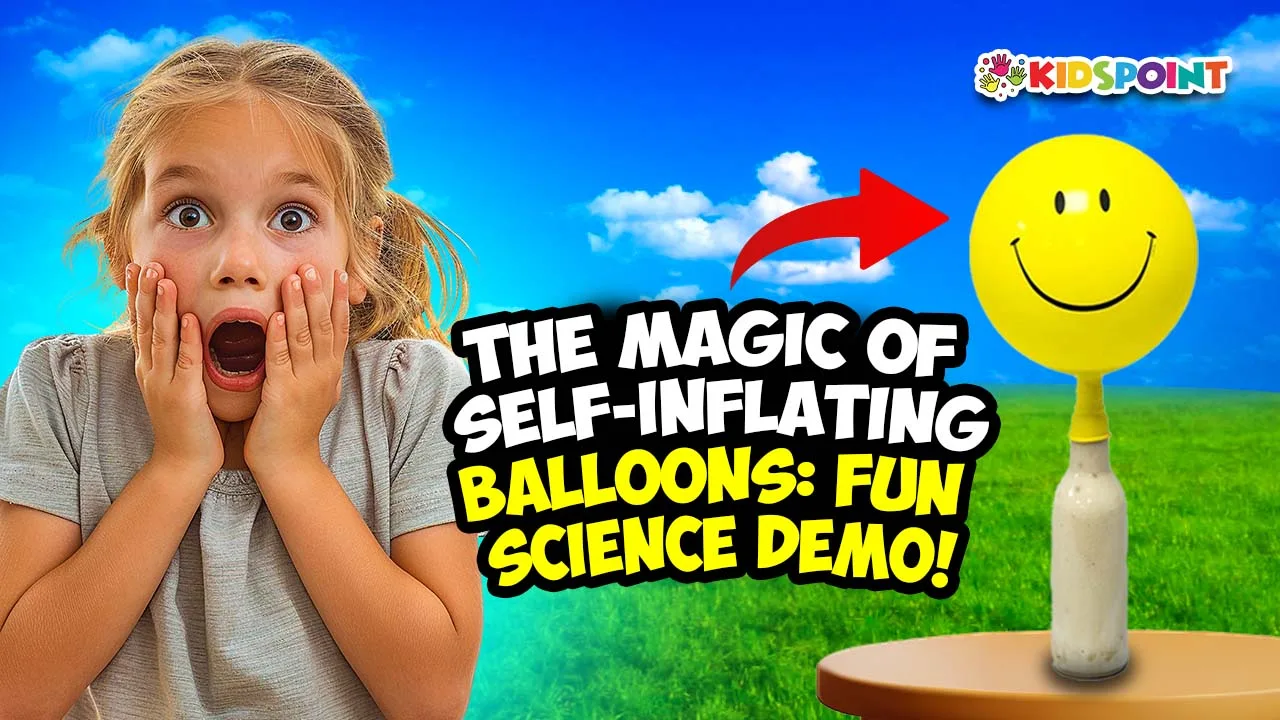
At The Kids Point , we believe that learning science can be just as fun as it is educational. Self-inflating balloons are a fantastic way to demonstrate the wonders of chemistry and physics in a way that’s engaging and magical. This demonstration involves a simple chemical reaction that inflates a balloon without the need for a pump. Here’s everything you need to know to create this exciting science demo, perfect for kids and families looking for a hands-on learning experience.
Understanding the Science Behind Self-Inflating Balloons
Self-inflating balloons are a product of a chemical reaction between baking soda and vinegar. When these two substances interact, they produce carbon dioxide gas, which inflates the balloon. To understand this process better, let’s break down the science involved:
- Chemical Reaction : The core of the self-inflating balloon is a simple acid-base reaction. Baking soda (sodium bicarbonate) is a base, and vinegar (acetic acid) is an acid. When mixed, they react to form carbonic acid, which quickly decomposes into carbon dioxide gas and water. The chemical equation for this reaction is: NaHCO3+CH3COOH→CO2+H2O+CH3COONa\text{NaHCO}_3 + \text{CH}_3\text{COOH} \rightarrow \text{CO}_2 + \text{H}_2\text{O} + \text{CH}_3\text{COONa}NaHCO3+CH3COOH→CO2+H2O+CH3COONa
- Gas Production : The carbon dioxide gas produced in this reaction is what causes the balloon to inflate. Carbon dioxide is a gas at room temperature and occupies more space than the solid or liquid reactants, so it pushes against the walls of the balloon, causing it to expand.
- Pressure and Volume : According to Boyle’s Law, if the volume of a gas increases (as the balloon expands), the pressure inside the balloon also increases until it reaches equilibrium with the external pressure. This is why the balloon continues to inflate until it reaches its maximum capacity.
Materials Needed
To demonstrate the magic of self-inflating balloons, you will need the following materials:
- Baking Soda : A common household item and the base in the reaction.
- Vinegar : An acid that reacts with baking soda.
- A Small Balloon : The self-inflating balloon in the demonstration.
- A Small Plastic Bottle : To contain the reaction.
- A Funnel : To help with adding baking soda to the balloon.
- A Measuring Spoon : For accurate measurement of baking soda.
- A Measuring Cup : For vinegar.
How to Make a Self-Inflating Balloon: Step-by-Step Instructions
- Prepare the Balloon : Using a funnel, carefully pour a few tablespoons of baking soda into the balloon. Make sure not to overfill the balloon, as it needs space to expand.
- Prepare the Vinegar Solution : Measure about 1/4 cup of vinegar and pour it into the plastic bottle. You can adjust the quantity depending on how much reaction you want to observe.
- Attach the Balloon : Stretch the mouth of the balloon over the opening of the plastic bottle, but make sure not to let the baking soda fall into the vinegar just yet.
- Initiate the Reaction : Once the balloon is securely attached to the bottle, lift the balloon so that the baking soda falls into the vinegar. Immediately, you will start to see bubbles forming as the reaction begins.
- Watch the Magic : As the reaction progresses, the balloon will start to inflate with carbon dioxide gas. This process may take a few seconds, so be patient and watch the balloon expand.
- Optional – Add More Baking Soda and Vinegar : If you want to extend the demonstration, you can repeat the process with more baking soda and vinegar.
Exploring the Science Behind the Fun
To deepen your understanding and make the demonstration more educational, consider explaining the following concepts:
- Reaction Rate : The rate at which the balloon inflates can be affected by the amount of baking soda and vinegar used. More of either reactant will speed up the reaction and produce more carbon dioxide gas.
- Gas Laws : Introduce basic concepts of gas laws, such as Boyle’s Law and Charles’s Law, to explain how gases behave under different conditions.
- Pressure and Volume : Discuss how the pressure inside the balloon increases as the volume of gas increases and how this relates to the balloon’s inflation.
- Safety Tips : Emphasize the importance of handling vinegar and baking soda safely, and ensure that the demonstration is conducted in a well-ventilated area.
Making It Fun: Variations and Extensions
To keep the fun going and explore more scientific concepts, try these variations and extensions of the self-inflating balloon demo:
- Color Changing Reaction : Add a few drops of food coloring to the vinegar before starting the reaction. This adds a visual element to the demonstration and makes it more engaging for kids.
- Different Types of Balloons : Experiment with balloons of different sizes and shapes to see how they affect the inflation process.
- Measurement and Comparison : Measure how much baking soda and vinegar are needed to inflate the balloon to different sizes. This can lead to discussions about measurement, volume, and chemical reactions.
- Temperature Effects : Conduct the experiment at different temperatures to see how temperature affects the reaction rate and the amount of gas produced.
- Alternative Gases : Explore other types of chemical reactions that produce gases, such as using yeast to produce carbon dioxide for inflating balloons.
Educational Value
The self-inflating balloon experiment is not only a fun and magical activity but also an excellent educational tool. It helps students understand chemical reactions, gas laws, and the principles of pressure and volume. The hands-on nature of the experiment makes complex scientific concepts more accessible and engaging, fostering a love for science and curiosity about the world.
By incorporating these concepts into your demonstration, you can make the self-inflating balloon experiment a memorable learning experience. Whether you’re a teacher, a parent, or just a science enthusiast, this simple yet captivating experiment offers endless opportunities for exploration and discovery.
The magic of self-inflating balloons at The Kids Point showcases the incredible science behind everyday chemical reactions. This fun and easy-to-perform demonstration provides a tangible way to explore key scientific concepts, making learning an exciting adventure. Gather your materials, invite friends and family, and let the magic of self-inflating balloons bring a touch of scientific wonder to your day!
Kids Science

IMAGES
COMMENTS
This classic science experiment is really one of my favorites. It is an easy science experiment to do and it really is exciting to watch. It creates a self-inflating balloon that kids think is the coolest! The reaction between the baking soda and vinegar cause the balloon to inflate all on its own! It is a show-stopper experiment for kids.
Next, secure the the mouth of the balloon over the top of the bottle. Tip: Don’t let any of the baking soda drop into the bottle…yet! While holding the bottle, lift the end of the balloon allowing the baking soda to drop into the bottle. Watch in amazement as the balloon magically inflates!
So this self inflating balloon science experiment is one he likes. It’s very easy to do too. And if your child is looking for a science project to do this year, you might want to have a look at this experiment. Topics: chemistry, air, carbon dioxide, balloon experiments, kitchen science. You will need: balloon; vinegar; baking soda ; funnel ...
Apr 10, 2018 · Why this Self Inflating Balloon Experiment is great for kids. They get the learn the outcome of a simple chemical reaction; They will learn about the properties of substances; This classic science experiment will pique their curiosity ; It takes just a few household staples for this fun science lesson; Supplies needed. latex balloon; 1 liter ...
The self-inflating balloon science experiment is a true science experiment that would be perfect for science fairs or a science lesson. What kids learn in this lesson is that different chemical reactions and gasses can be used to inflate balloons.
Gently shake the balloon until all the baking soda goes to the bottom. Making sure none of the baking soda gets into the water bottle, carefully stretch the opening of the balloon until it’s completely over the opening of the water bottle. If it’s not a tight fit, your balloon is probably too big and you should use a smaller one instead.
In this simple science experiments video, we go over how to make a self-inflating balloon using just a bottle, bicarbonate of soda, vinegar and (of course) a...
The Science Behind the Self-Inflating Balloon Experiment Alka-seltzer tablets and baking soda and vinegar both produce the same CO2 reaction. When an acid is mixed with a base, the two mixtures react through an endothermic reaction (a reaction that makes the mixture feel colder), creating CO2 gas which bubbles up through the liquid and out into ...
Mar 25, 2020 · Self-Inflating Balloon Experiment Variations . Children will have a blast testing all sorts of variations to this experiment. Try these variations to see which chemical reaction is best at inflating a balloon! To make the self-inflating balloon experiment even more educational, record your hypotheses and analyze the effects. 1. Size
Sep 4, 2024 · To demonstrate the magic of self-inflating balloons, you will need the following materials: Baking Soda: A common household item and the base in the reaction. Vinegar: An acid that reacts with baking soda. A Small Balloon: The self-inflating balloon in the demonstration. A Small Plastic Bottle: To contain the reaction.